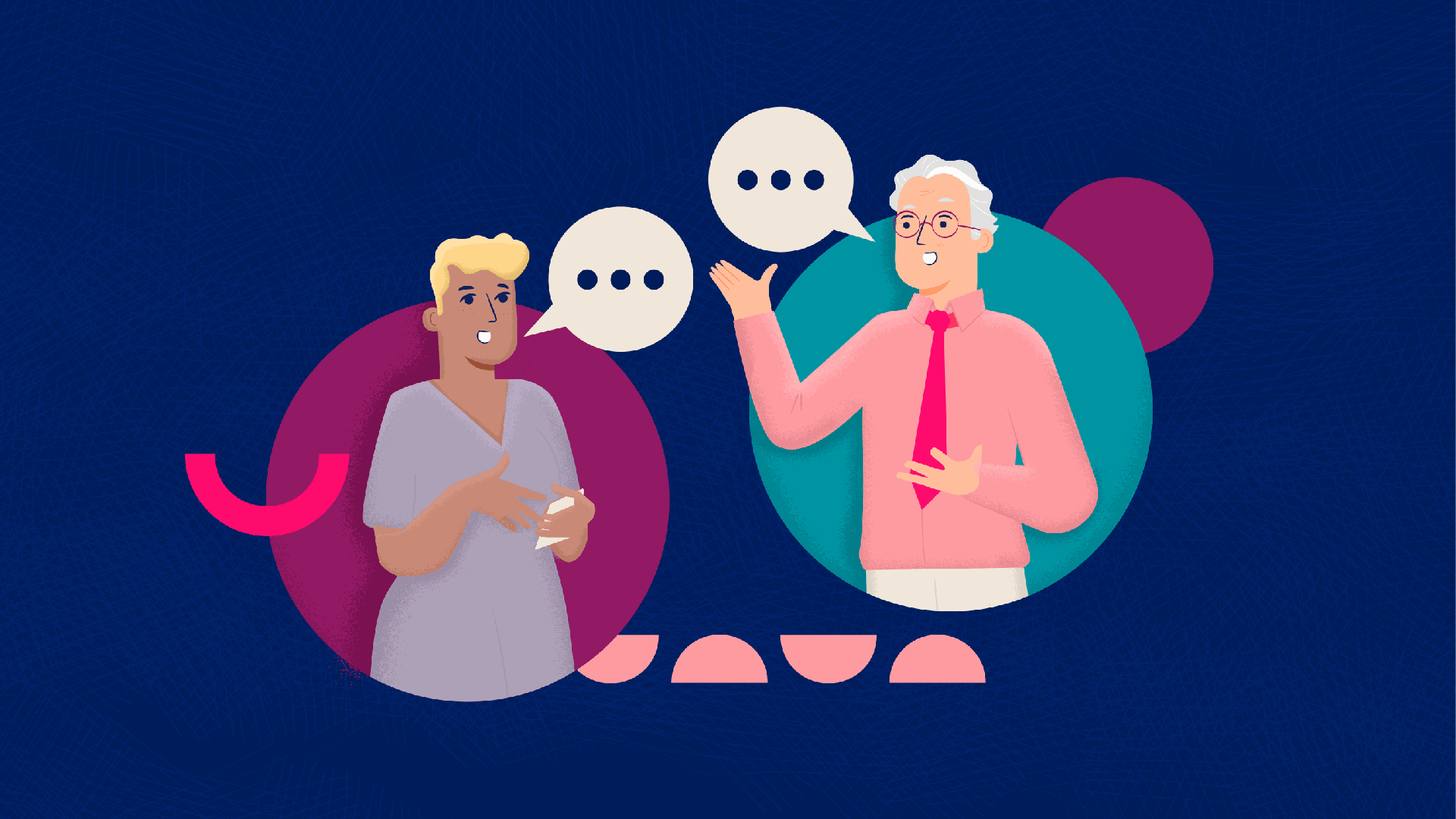
So you’re having a conversation that’s starting to peter out, and you don’t want it to end. You want to continue talking to this person. Maybe it’s a new friend, a potential partner (business or romantic—take your pick), a prospective client or customer, a co-worker you want to get to know better, someone you admire in your field, or even a fascinating stranger. In any case, you’re wondering: How do I keep the conversation going?
Well, wonderer, wonder no longer.
Here at Ruby, it’s our job to engage in conversations. We talk to, listen to, laugh with, empathize with, and delight people online and over the phone, 24 hours a day, 7 days a week. In this article, we’ll share some of our conversational insights.
Let’s dive in, starting with why conversations can be so doggone difficult.
Table of contents
The art of the conversation
Conversations: most of us have them multiple times a day, but not all of us consider ourselves particularly good at them. How many times has a conversation you’re having ended abruptly or awkwardly, and you found yourself thinking: What just happened?
What happened is you participated in a complex, unrehearsed verbal exchange of ideas, as millions of neurochemical interactions fired off in that big human brain of yours. It’s a wonder you were able to utter coherent words at all!
That is to say, conversations are tough. They take a lot out of us. Don’t beat yourself up when they don’t go perfectly, or as well as you’d hoped. Even the best conversationalists stumble now and then—which brings us to our next point…
Few people are natural conversationalists. For most, mastering verbal interactions takes dedicated practice. And it’s a markedly different skill set from public speaking. You may be a phenomenal presenter with a captivating, sonorous voice—the type of person who commands attention—but that doesn’t necessarily make you a great conversationalist. Sure, you can talk at people, but what about talking with people?
Indeed, keeping a conversation going is usually less about how much talking you do and much more about how much listening you do. But we’ll get to that a little later. For now, let’s look at some reasons you might want to keep a conversation from stalling too early.
Reasons to stay in a conversation
Many of us look for ways to end the conversation early to save ourselves from wasting time or potential embarrassment. But there are times when you genuinely want the conversation to keep going.
Maybe you want to…
- Learn more about another person
- Learn more about an interesting topic
- Change someone’s mind
- Persuade someone to do or not do something
- Influence someone’s opinion or emotions
- Make a lasting impression
- Have fun and pass the time
If it’s a business conversation, such as a conversation with a customer, sales lead, vendor, manager, or employee, you might want to…
- Close a deal
- Make a sale
- Negotiate an agreement
- Convince someone your business is superior to a competitor
- Coach an employee or team member
- Generate ideas
- Help someone else see the value of your ideas
- Encourage team members to share their thoughts and perspectives
A good conversation is particularly important—and sadly, too rare—in the business world. When you truly (madly) deeply relate to someone, you free them for a moment from the noisy, salesy, attention-seeking world we live in. It humanizes you and makes you worth remembering and doing business with again.
In any case, what you’re ultimately doing is creating a connection. So, let’s explore some ways to keep a conversation going by bringing connections to the forefront.
How to keep a conversation going: 7 tips and tricks
1. Treat the conversation like a late-night interview.
You know what everyone likes talking about? Themselves. One of the easiest ways to establish common ground with another person is to make the conversation about them. Treat them as the most fascinating person in the world (even if they aren’t) and put yourself in the role of the interviewer.
Get to know them. Ask them questions, ideally about things they’re passionate about—their hobbies, job, interests, goals, beliefs, ideas. Even if the topic don’t seem relevant to the “point” of the conversation, it shows the other person you’re interested in them and what they have to say, establishing trust and helping them open up.
The reliable question-asking trick never gets old. Maybe you’ve spoken to someone a hundred times, but there’s always something new to find out when you ask more questions.
But did you know that some questions are better than others? (See what I did there? I asked a question.)
2. Stay away from yes-or-no questions.
Simple yes or no questions are excellent ways to end a conversation. They tend to result in blunt, short responses (those would be “yes” or “no,” sometimes “maybe,” and now and then a fancy “well, it depends”). They usually don’t elicit the profound thoughts that keep conversations going.
Instead, try open-ended questions. We’re talking about the what-do-feel-abouts the why-is-thats, and the how-would-yous. These types of require the other person to share their thoughts, feelings, and opinions, necessarily extending a conversation. They’re also great ways to share control of the exchange and create a productive back-and-forth.
Open-ended questions usually begin with these words and phrases:
- Why…
- How…
- What…
- Tell me about…
- Could you describe…
- What do you think about…
Open-ended questions encourage the other person to expand on their thoughts, allowing them to feel heard and giving you more information. The point here is not to get too personal or come off as nosy, but to get a longer (and more interesting) answer out of the person.
Here are a few examples of open-ended question stems to try:
- What kind of challenges are you facing?
- How does this make you feel?
- What led you to that point?
- What’s most important to you?
- What are your expectations?
- What concerns do you have?
- What would you like to improve?
The specifics of these sorts of questions will change given the context of the conversation and who you are talking to. But whether it’s a business contact or a first date, try to stick with questions that begin with who, what, where, when, and why as you first get used to asking open-ended questions.
3. Keep the conversation going by being a good listener.
Beyond asking good questions, you need to make the time for the other person to answer them. People often get so caught up in what they want to say that they forget to listen to others.
I’m talking about honestly and sincerely listening—active listening, as one might call it. It’s about not just hearing someone, but as processing and reflecting on what they said. And it’s a skill that we all need to practice. With active listening, we can all connect better during conversations.
Active listening techniques:
- Paying attention
- Not judging what the other person is saying
- Reflecting or paraphrasing
- Clarifying
- Summarizing
- Sharing
Only after you focused on the other person, understood and clarified what they’ve said, and summarized back to them what they said should you then offer your thoughts, feelings, and suggestions. The more time you devote to listening during your conversations, the better and longer your discussions will be. Listening helps you build connections and foster relationships—powerful tools for growing your business.
4. Minimize distractions.
We live in a very distracted and distractable world. Texts, tweets, ads, pets, kids, cars, that thing in the bushes over there—distractions are everywhere, making it difficult for us to listen and respond during conversations.
If you’re the type of person who walks through life phone glued in hand, well, that’s one major distraction you can eliminate—simply by slipping your phone into a drawer or placing it face down during a conversation.
Of course, that’s just one item on a seemingly endless list. While it’s impossible to eliminate all distractions, being mindful of what might distract you during a conversation and trying to avoid those things will go a long way in helping you have productive conversations and create better connections with the people around you.
Consider how you can avoid common distractions during a conversation:
- Put away your phone.
- Have conversations away from people in your workspace.
- Reduce background noise (such as sounds of traffic outside, loud appliances, and pets.)
- Silence emails and other notifications on your devices.
- Reduce the number of displays or screens around you.
- Be mindful of your news and social media consumption habits.
- Minimize clutter in your space.
Keep in mind that some things that seem like distractions can actually facilitate better conversations. Some people listen more effectively while doodling or fiddling with objects.
Learn what works best for you and be honest with yourself when you feel the urge to multitask during a conversation. Do you really need to do something else when you’re speaking to someone, or are you avoiding being present?
5. Embrace moments of silence.
Feeling like you need to fill every silent moment in a conversation takes opportunities to speak and be heard away from others. Moments of silence happen, and they can be necessary. Maybe someone needs a moment to think, or reflect, or carefully consider what they want to say.
Embrace the opportunity to practice your listening and show the other person the conversation is in their hands. You might be surprised at where the conversation goes next.
6. Be mindful of interrupting.
I’m particularly guilty of this one, especially over the phone. Interrupting can be an innocent mistake, but it quickly becomes frustrating for the other person.
Don’t find yourself so excited to blurt out your next thought that you speak over and interrupt the other person—or worse, stop listening. When you’re feeling pumped up in a conversation, take a moment to slow down. Breathe. Collect yourself.
Again, interrupting happens regardless of how careful you are. Don’t dwell on it; simply apologize and try and refocus on your active listening. If you find yourself guilty of frequent interruptions, it might be time to do some self-reflection and practice those listening skills in your day-to-day conversations.
7. Prepare in advance.
Okay, this last one isn’t possible every time. Spontaneity is key to many great conversations and meaningful connection. But if you can go into a conversation with a goal and game plan in mind, you’ll be better-equipped to keep the conversation going.
Think about…
- What questions you want to ask
- What questions you should be prepared to answer
- Where you might run into disagreements with the other person
- How you’ll handle objections
- How you want the other person to feel
- What you want the other person to do once the conversation is over
Do allow room for some flexibility. Keep in mind that the questions you ask and the answers you get might lead down different paths than you planned. Still, if the goal is to keep the conversation going and get as much information as possible, you may be able to get things back on track after the tangent.

Conversations are an art—but I truly believe they’re an art anyone can learn. In many cases, all it takes to keep a conversation going is patience, curiosity, and a few basic practices:
- Asking open-ended questions
- Active listening
- Giving someone your full attention
- Letting go of total control
- Slowing down
- Planning ahead
Regardless of how long your conversations are, what matters most is human connection. Connection is the basis of everything successful humans and businesses do—and it’s more important than ever as our world grows more digital and omnichannel.
Visit Ruby’s Small Business Hub for more ways to connect with the people you serve in your business.



